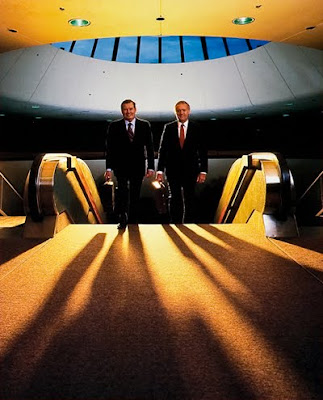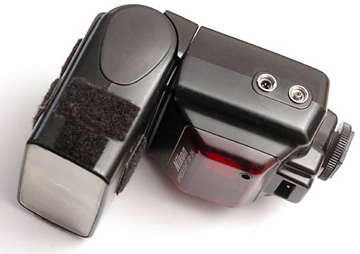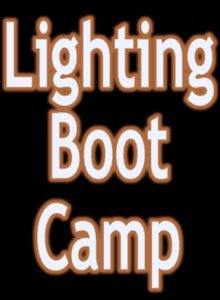 To appreciate what a Lighting Rock Star Dean Collins was in the late 80's, you really had to be at one of his seminars.
To appreciate what a Lighting Rock Star Dean Collins was in the late 80's, you really had to be at one of his seminars.Imagine yourself and a couple hundred other photographers sitting, mesmerized, in a hotel ballroom as a half dozen synchronized Hasselblad slide projectors took turns unlocking secrets and opening doors in their brains.
And talking non-stop at the front of the room was Collins, never standing still for a moment. His hands constantly gesturing, his delivery machine-gun fast. But somehow, your brain processed it all.
You were a rat and he was the Pied Piper, leading you out of the dark ages.
There was no time to take notes. It was enough just to listen and try to keep up with the guy. And you couldn't not pay attention. Because you were starting to get it.
And he couldn't slow down if he wanted to. Because he had so much to tell you.
Those of us who are a little older remember how his techniques took the commercial photo world by storm. He started out playing with PVC pipes to make his own gear. Soon, Bogen was marketing "Lightforms," which were designed right out of his "Tinker Tubes" notebook.
All of this lighting mania led to a series of books, and later, videotapes. Photographers watched them repeatedly. And they adapted their methods to embrace what they had learned.
Sadly, Collins passed away last year after a three-year fight with cancer.
Thankfully, his willingness to share his knowledge via books and VHS tapes means that he will be able to go on teaching future generations of photographers.
The Best of Dean Collins on Lighting is a new, 4-DVD, 6-hour compilation of the best of his VHS series.
And the one weakness in these DVDs stems from the state of the art in video production at the time the VHS tapes were produced. You'll notice a lack of the sharpness and resolution that we all take for granted in this day of HDTV and 10-megapixel consumer cameras.
But the weakness stops there.
The content of these tapes is timeless. The clothing styles may scream 1980's, but the lighting techniques are just as valid today as they ever were.
And unless someone repeals the laws that govern light and physics, they will continue to be applicable for the foreseeable future.
The "Best of Dean Collins on Lighting" DVD set began shipping this month.
Mine arrived via UPS as I was waiting to pick my kids up at the bus stop. I saw the brown truck drive past. I saw him pull up to my house. I knew what he had for me.
But when you have a five-year-old who has just started kindergarten, you don't bail on him to run back to your house to see the new DVDs. You pick him up at the bus stop.
About three years later the bus arrived with Ben and his older sister, Emily. We headed back to the house.
All four DVDs ship in one double-width clamshell case. The first three discs contain between eight and ten full, commercial shoot breakdowns. Disc number four is simply entitled "Basics."
It is disc four that you should watch first. In it, Collins introduces you to his philosophy of lighting by using one, small battery-powered flash. Before it is over, he will show you the big guns at the big shoots. But the principals hold true right down to the small stuff.
As you watch it, you learn about the different areas of a lit, 3-D object. If terms like "diffused highlight" and "specular-to-diffused transfer" mean nothing to you now, get ready for them to start popping into your head every time you hold an apple up to the light before you take a bite.
Collins takes us through several portrait shoots using one modestly-powered flash - and a high-powered brain. These are the early productions, and he was still using some home-fashioned light control gear.
That's a good thing, because the commercial Bogen versions are very difficult to find these days. Maybe on eBay, if you're lucky.
But that's okay, because you can make this stuff. I'll be making some panels and documenting the process on this site soon. More fun than buying it, anyway.
Your appetite whet by the basic concepts, you are off to the races.
There are 27 shoots broken down in the remaining three discs. Each one of them will leave you with a mixture of awe and a feeling of "Hey, I could have done that!"
That's because he was (is) such a good teacher. And he doesn't just teach you a bag of tricks, either. Along the way, you learn how to think about light. Midway through the DVD's you find yourself anticipating the solutions to the lighting problems he faces.
I would imagine it is very much like the experience of a fellow photographer I know who spent most of his childhood in his native Korea. Years later, he stopped in amazement while walking down a street in the US. It had just occurred to him that, for the first time, he was thinking in English.
There are far too many examples to do the DVDs justice, so I will run through some of my favorites:
• A pair of tennis shoes, shot on 8x10 film, and exquisitely lit from all angles (including underneath) for a catalog shot.
• A stunning, "in-motion" shot of a Yamaha street bike and rider shot on 8x10 large format and lit with four, small quartz lights. And 8-seconds of exposure time in which to do some quick, in-camera "Photoshopping." (The ubiquitous program was not yet invented when this photo was made.)
• Various, outdoor photo sessions that turn ugly, mid-day light into a beautiful environment using reflectors, diffusers and mirrors. So, yeah, magic is done with mirrors.
• And this annual report cover shot in five minutes (with lots of prep time) at an airport with two airline executives:

This image reminds me of a favorite story Collins used to tell.
This was one of those instances where he used about a gazillion watt-seconds to transform a large, ambient environment for a photo. As it happens, he was using optical slaves to trip the lights.
Well, they had everything all set up and were waiting for the execs when an elderly Japanese couple walked by with a small, point-and-shoot camera.
If you are a photo bug and walk past a setup like this, you're gonna want to snap a souvenir shot. Even though your camera only has a dinky little flash that cannot possibly ever hope to light such a big area.
Except for this time.
In the instant the the tourist tripped his shutter, thousands of watt-seconds were released as all of the strobes went off at once.
I would have loved to see the look on their faces. I would also love to see their picture.
They learned a lot about light that day, too.


















